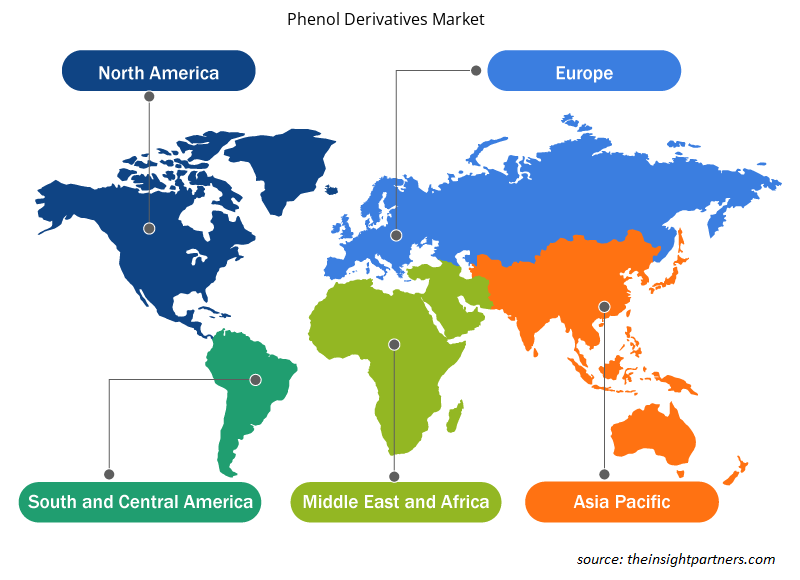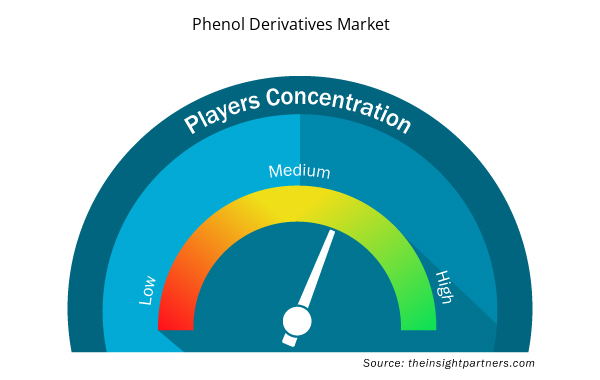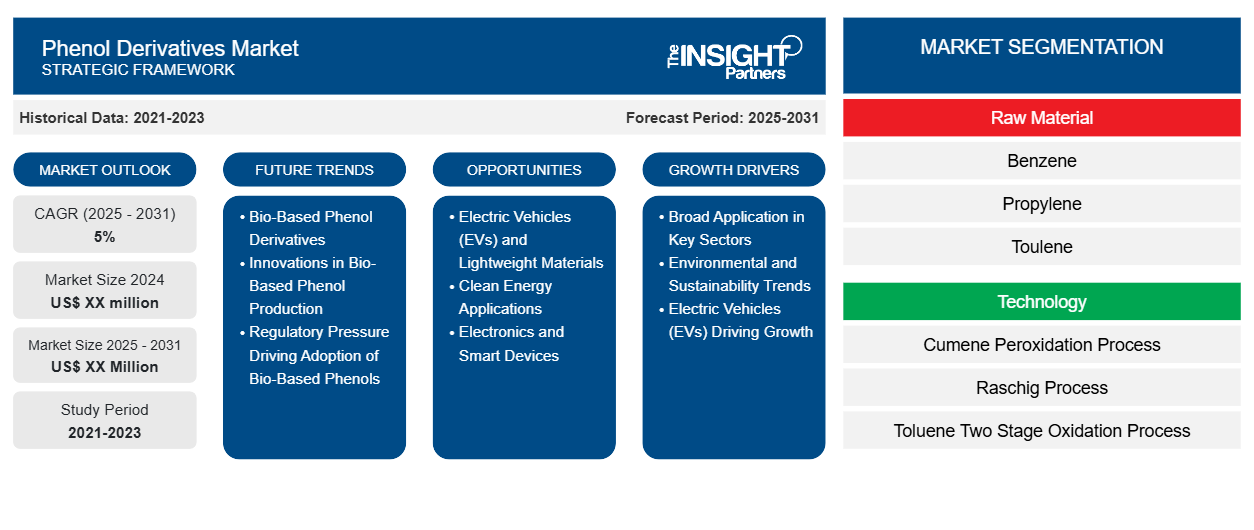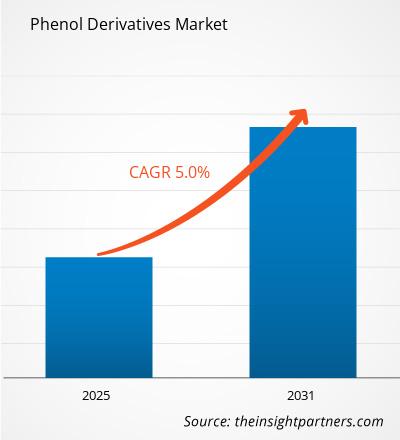Si prevede che il mercato dei derivati del fenolo registrerà un CAGR del 5% dal 2023 al 2031, con una dimensione di mercato in espansione da XX milioni di dollari USA nel 2023 a XX milioni di dollari USA entro il 2031.CAGR of 5% from 2023 to 2031, with a market size expanding from US$ XX million in 2023 to US$ XX Million by 2031.
Il rapporto presenta un'analisi basata sulla materia prima (benzene, propilene e toluene). Il rapporto è segmentato per tecnologia (processo di perossidazione del cumene, processo raschig, processo di ossidazione a due stadi del toluene e processo di solfonazione). Il rapporto è segmentato per derivato (bisfenolo-A, resine fenoliche, caprolattame, alchil fenolo e altri). L'analisi globale è ulteriormente suddivisa a livello regionale e nei principali paesi. Le dimensioni del mercato e le previsioni a livello globale, regionale e nazionale per tutti i principali segmenti di mercato sono coperte nell'ambito. Il rapporto offre il valore in USD per l'analisi e i segmenti di cui sopra. Il rapporto fornisce statistiche chiave sullo stato di mercato dei principali attori del mercato e offre tendenze e opportunità di mercato.
Scopo del rapporto
Il report Phenol Derivatives Market di The Insight Partners mira a descrivere il panorama attuale e la crescita futura, i principali fattori trainanti, le sfide e le opportunità. Ciò fornirà spunti a vari stakeholder aziendali, come:
- Fornitori/produttori di tecnologia: per comprendere le dinamiche di mercato in evoluzione e conoscere le potenziali opportunità di crescita, consentendo loro di prendere decisioni strategiche informate.
- Investitori: condurre un'analisi completa delle tendenze in merito al tasso di crescita del mercato, alle proiezioni finanziarie del mercato e alle opportunità esistenti lungo la catena del valore.
- Enti di regolamentazione: regolamentano le politiche e le attività di controllo sul mercato allo scopo di ridurre al minimo gli abusi, preservare la fiducia degli investitori e sostenere l'integrità e la stabilità del mercato.
Segmentazione del mercato dei derivati del fenolo
Materia prima
- Benzene
- Propilene
- Toulene
Tecnologia
- Processo di perossidazione del cumene
- Processo Raschig
- Processo di ossidazione a due stadi del toluene
- Processo di solfonazione
Derivato
- Bisfenolo-A
- Resine fenoliche
- Caprolattame
- Alchil fenolo
Geografia
- America del Nord
- Europa
- Asia-Pacifico
- America del Sud e Centro
- Medio Oriente e Africa
Geografia
- America del Nord
- Europa
- Asia-Pacifico
- America del Sud e Centro
- Medio Oriente e Africa
Personalizza questo report in base alle tue esigenze
Riceverai la personalizzazione gratuita di qualsiasi report, comprese parti di questo report, o analisi a livello nazionale, pacchetto dati Excel, oltre a usufruire di grandi offerte e sconti per start-up e università
- Scopri le principali tendenze di mercato in questo rapporto.Questo campione GRATUITO includerà analisi di dati che spaziano dalle tendenze di mercato alle stime e alle previsioni.
Fattori trainanti della crescita del mercato dei derivati del fenolo
- Ampia applicazione in settori chiave: il mercato dei derivati fenolici si è sviluppato sulla base della crescente domanda in vari settori. I composti fenolici vengono applicati nella produzione di materie plastiche, resine e adesivi, elementi chiave nei settori automobilistico, edile e dei beni di consumo. Questa vasta area di applicazioni stimola l'innovazione sostenuta e nuove espansioni di capacità.
- Tendenze ambientali e di sostenibilità: oltre a tali fattori, le tendenze di mercato dovute ai prodotti ecosostenibili stanno anche cambiando il modo in cui le industrie dovrebbero approcciarsi al mercato con alternative sostenibili. Pertanto, i produttori hanno iniziato a esaminare i fenoli e i derivati di origine biologica. Ciò riflette gli obiettivi di sostenibilità globale da un lato e attrae l'attenzione dei consumatori attenti all'ambiente, aumentando così il potenziale di mercato e guidando gli investimenti per la ricerca e lo sviluppo di alternative più ecologiche.
- Veicoli elettrici (EV) che guidano la crescita: anche l'industria automobilistica continua a contribuire in modo significativo alla crescita di questo mercato. È necessaria una maggiore produzione di materiali leggeri e compositi avanzati per migliorare le prestazioni e la durata, poiché qui vengono utilizzate resine fenoliche. Inoltre, con l'ascesa dei veicoli elettrici, la domanda di materiali ad alte prestazioni come i derivati del fenolo alimenterà ancora di più questo mercato.
Tendenze future del mercato dei derivati del fenolo
- Derivati del fenolo di origine biologica: una soluzione sostenibile: tra gli sviluppi imminenti che si rifletterebbero direttamente sulle caratteristiche fenomenologiche del mercato dei derivati del fenolo c'è lo sviluppo di derivati del fenolo di origine biologica. Poiché le aziende cercano i modi più rispettosi dell'ambiente per trovare fonti sostitutive al posto delle tradizionali fonti derivate dal petrolchimico, anche le fonti rinnovabili per i fenoli di origine biologica acquisiscono molta importanza non solo perché tendono a ridurre significativamente l'impronta di carbonio, ma sono anche perfettamente allineate con gli obiettivi di sostenibilità stabiliti dalle nazioni del mondo.
- Innovazioni nella produzione di fenoli di origine biologica: i vantaggi della tecnologia e dello sviluppo dei processi in termini di innovazioni relative alla produzione di fenoli di origine biologica derivano dalla loro ricerca con varie fonti di biomassa. Queste fonti includono lignina e materiali vegetali. Tali nuovi sviluppi consentono un'estrazione efficiente di composti fenolici, il che rende i fenoli di origine biologica più praticabili ed economicamente fattibili rispetto ai fenoli tradizionali per molte applicazioni.
- Pressione normativa che spinge all'adozione di fenoli di origine biologica: la crescente pressione normativa per adottare pratiche più ecologiche spinge la domanda di questi derivati fenolici di origine biologica. Questa tendenza è destinata a essere un grande stimolo verso la crescita del mercato e l'attrazione degli investimenti, così come la collaborazione tra le parti interessate all'interno del settore chimico, poiché le aziende sviluppano prodotti sostenibili che soddisfano le preferenze dei consumatori per materiali ecocompatibili.
Opportunità di mercato dei derivati del fenolo
- Veicoli elettrici (EV) e materiali leggeri: le industrie emergenti stanno innescando nuove applicazioni che portano a enormi opportunità di crescita nel mercato dei derivati fenolici. L'industria dei veicoli elettrici sta sempre più sfruttando le resine fenoliche nella produzione di componenti per batterie e materiali da costruzione leggeri, mentre i derivati fenolici vengono utilizzati in compositi avanzati, che sono fondamentali per migliorare la funzionalità e l'efficienza energetica del veicolo.
- Applicazioni di energia pulita: il settore dell'energia pulita offre un'altra promettente opportunità poiché i derivati del fenolo sono utilizzati anche nella fabbricazione di pale di turbine eoliche e pannelli solari. Questi materiali possiedono una grande stabilità meccanica e termica, venendo quindi utilizzati nel ringiovanimento delle fonti energetiche. Il crescente utilizzo nei dispositivi intelligenti e nella tecnologia IoT richiede anche materiali ad alte prestazioni in grado di resistere allo stress nei componenti elettronici.
- Elettronica e dispositivi intelligenti: i derivati del fenolo hanno applicazioni mediche e biotecnologiche nei sistemi di somministrazione di farmaci, impianti, imballaggi avanzati e dispositivi in ambito sanitario. Queste applicazioni sono orientate verso materiali che possiedono determinate caratteristiche come resistenza chimica e biocompatibilità. Esiste anche un potenziale per l'applicazione di sostanze fenoliche nell'aspetto della produzione e della prototipazione tramite la tecnologia di stampa 3D.
Approfondimenti regionali sul mercato dei derivati del fenolo
Le tendenze regionali e i fattori che influenzano il mercato dei derivati del fenolo durante il periodo di previsione sono stati ampiamente spiegati dagli analisti di Insight Partners. Questa sezione discute anche i segmenti e la geografia del mercato dei derivati del fenolo in Nord America, Europa, Asia Pacifico, Medio Oriente e Africa e America meridionale e centrale.

- Ottieni i dati specifici regionali per il mercato dei derivati del fenolo
Ambito del rapporto di mercato sui derivati del fenolo
| Attributo del report | Dettagli |
|---|---|
| Dimensioni del mercato nel 2023 | XX milioni di dollari USA |
| Dimensioni del mercato entro il 2031 | XX milioni di dollari USA |
| CAGR globale (2023-2031) | 5% |
| Dati storici | 2021-2022 |
| Periodo di previsione | 2024-2031 |
| Segmenti coperti | Per materia prima
|
| Regioni e Paesi coperti | America del Nord
|
| Leader di mercato e profili aziendali chiave |
|
Densità degli attori del mercato dei derivati del fenolo: comprendere il suo impatto sulle dinamiche aziendali
Il mercato dei derivati del fenolo sta crescendo rapidamente, spinto dalla crescente domanda degli utenti finali dovuta a fattori quali l'evoluzione delle preferenze dei consumatori, i progressi tecnologici e una maggiore consapevolezza dei benefici del prodotto. Con l'aumento della domanda, le aziende stanno ampliando le loro offerte, innovando per soddisfare le esigenze dei consumatori e capitalizzando sulle tendenze emergenti, il che alimenta ulteriormente la crescita del mercato.
La densità degli operatori di mercato si riferisce alla distribuzione di aziende o società che operano in un particolare mercato o settore. Indica quanti concorrenti (operatori di mercato) sono presenti in un dato spazio di mercato in relazione alle sue dimensioni o al valore di mercato totale.
Le principali aziende che operano nel mercato dei derivati del fenolo sono:
- Allnex Belgio SA
- Altivia Petrolchimica LLC
- Boreale
- Società petrolchimica Chang Chun Ltd.
- Prodotti chimici DOMO
Disclaimer : le aziende elencate sopra non sono classificate secondo un ordine particolare.

- Ottieni una panoramica dei principali attori del mercato dei derivati del fenolo
Punti di forza chiave
- Copertura completa: il rapporto copre in modo completo l'analisi di prodotti, servizi, tipologie e utenti finali del mercato dei derivati del fenolo, fornendo una panoramica olistica.
- Analisi degli esperti: il rapporto è compilato sulla base della conoscenza approfondita di esperti e analisti del settore.
- Informazioni aggiornate: il rapporto garantisce la pertinenza aziendale grazie alla copertura di informazioni recenti e tendenze nei dati.
- Opzioni di personalizzazione: questo report può essere personalizzato per soddisfare le esigenze specifiche del cliente e adattarsi in modo appropriato alle strategie aziendali.
Il rapporto di ricerca sul mercato dei derivati del fenolo può, quindi, aiutare a guidare il percorso di decodificazione e comprensione dello scenario del settore e delle prospettive di crescita. Sebbene possano esserci alcune preoccupazioni valide, i vantaggi complessivi di questo rapporto tendono a superare gli svantaggi.
- Analisi storica (2 anni), anno base, previsione (7 anni) con CAGR
- Analisi PEST e SWOT
- Valore/volume delle dimensioni del mercato - Globale, regionale, nazionale
- Industria e panorama competitivo
- Set di dati Excel



Report Coverage
Revenue forecast, Company Analysis, Industry landscape, Growth factors, and Trends

Segment Covered
This text is related
to segments covered.

Regional Scope
North America, Europe, Asia Pacific, Middle East & Africa, South & Central America

Country Scope
This text is related
to country scope.
Domande frequenti
The development of bio-based phenol derivatives is expected to be the key market trends.
Based on geography, Asia Pacific held the largest share of the phenol derivatives market driven by China, which serves as both the largest producer and consumer of phenol derivatives globally. The region's strong manufacturing base, coupled with extensive chemical production facilities and a robust presence of end-user industries, has solidified its market leadership position.
Based on raw material, the propylene segment is expected to witness the fastest growth during the forecast period
The increasing demand across various industries is driving the market growth.
Allnex Belgium SA; Altivia Petrochemicals LLC; Borealis; Chang Chun Petrochemical Co. Ltd.; DOMO Chemicals; Georgia Gulf Corporation; Hexion LLC; Kumho Petrochemical Co., Ltd.; Royal Dutch Shell PLC; and Saudi Basic Industries Corporation are some of the key players operating in the phenol derivatives market
The Phenol Derivatives Market is estimated to witness a CAGR of 5% from 2023 to 2031
Trends and growth analysis reports related to Chemicals and Materials : READ MORE..
1. Allnex Belgium SA
2. Altivia Petrochemicals LLC
3. Borealis
4. Chang Chun Petrochemical Co. Ltd.
5. DOMO Chemicals
6. Georgia Gulf Corporation
7. Hexion LLC
8. Kumho Petrochemical Co., Ltd.
9. Royal Dutch Shell PLC
10. Saudi Basic Industries Corporation
The Insight Partners performs research in 4 major stages: Data Collection & Secondary Research, Primary Research, Data Analysis and Data Triangulation & Final Review.
- Data Collection and Secondary Research:
As a market research and consulting firm operating from a decade, we have published and advised several client across the globe. First step for any study will start with an assessment of currently available data and insights from existing reports. Further, historical and current market information is collected from Investor Presentations, Annual Reports, SEC Filings, etc., and other information related to company’s performance and market positioning are gathered from Paid Databases (Factiva, Hoovers, and Reuters) and various other publications available in public domain.
Several associations trade associates, technical forums, institutes, societies and organization are accessed to gain technical as well as market related insights through their publications such as research papers, blogs and press releases related to the studies are referred to get cues about the market. Further, white papers, journals, magazines, and other news articles published in last 3 years are scrutinized and analyzed to understand the current market trends.
- Primary Research:
The primarily interview analysis comprise of data obtained from industry participants interview and answers to survey questions gathered by in-house primary team.
For primary research, interviews are conducted with industry experts/CEOs/Marketing Managers/VPs/Subject Matter Experts from both demand and supply side to get a 360-degree view of the market. The primary team conducts several interviews based on the complexity of the markets to understand the various market trends and dynamics which makes research more credible and precise.
A typical research interview fulfils the following functions:
- Provides first-hand information on the market size, market trends, growth trends, competitive landscape, and outlook
- Validates and strengthens in-house secondary research findings
- Develops the analysis team’s expertise and market understanding
Primary research involves email interactions and telephone interviews for each market, category, segment, and sub-segment across geographies. The participants who typically take part in such a process include, but are not limited to:
- Industry participants: VPs, business development managers, market intelligence managers and national sales managers
- Outside experts: Valuation experts, research analysts and key opinion leaders specializing in the electronics and semiconductor industry.
Below is the breakup of our primary respondents by company, designation, and region:

Once we receive the confirmation from primary research sources or primary respondents, we finalize the base year market estimation and forecast the data as per the macroeconomic and microeconomic factors assessed during data collection.
- Data Analysis:
Once data is validated through both secondary as well as primary respondents, we finalize the market estimations by hypothesis formulation and factor analysis at regional and country level.
- Macro-Economic Factor Analysis:
We analyse macroeconomic indicators such the gross domestic product (GDP), increase in the demand for goods and services across industries, technological advancement, regional economic growth, governmental policies, the influence of COVID-19, PEST analysis, and other aspects. This analysis aids in setting benchmarks for various nations/regions and approximating market splits. Additionally, the general trend of the aforementioned components aid in determining the market's development possibilities.
- Country Level Data:
Various factors that are especially aligned to the country are taken into account to determine the market size for a certain area and country, including the presence of vendors, such as headquarters and offices, the country's GDP, demand patterns, and industry growth. To comprehend the market dynamics for the nation, a number of growth variables, inhibitors, application areas, and current market trends are researched. The aforementioned elements aid in determining the country's overall market's growth potential.
- Company Profile:
The “Table of Contents” is formulated by listing and analyzing more than 25 - 30 companies operating in the market ecosystem across geographies. However, we profile only 10 companies as a standard practice in our syndicate reports. These 10 companies comprise leading, emerging, and regional players. Nonetheless, our analysis is not restricted to the 10 listed companies, we also analyze other companies present in the market to develop a holistic view and understand the prevailing trends. The “Company Profiles” section in the report covers key facts, business description, products & services, financial information, SWOT analysis, and key developments. The financial information presented is extracted from the annual reports and official documents of the publicly listed companies. Upon collecting the information for the sections of respective companies, we verify them via various primary sources and then compile the data in respective company profiles. The company level information helps us in deriving the base number as well as in forecasting the market size.
- Developing Base Number:
Aggregation of sales statistics (2020-2022) and macro-economic factor, and other secondary and primary research insights are utilized to arrive at base number and related market shares for 2022. The data gaps are identified in this step and relevant market data is analyzed, collected from paid primary interviews or databases. On finalizing the base year market size, forecasts are developed on the basis of macro-economic, industry and market growth factors and company level analysis.
- Data Triangulation and Final Review:
The market findings and base year market size calculations are validated from supply as well as demand side. Demand side validations are based on macro-economic factor analysis and benchmarks for respective regions and countries. In case of supply side validations, revenues of major companies are estimated (in case not available) based on industry benchmark, approximate number of employees, product portfolio, and primary interviews revenues are gathered. Further revenue from target product/service segment is assessed to avoid overshooting of market statistics. In case of heavy deviations between supply and demand side values, all thes steps are repeated to achieve synchronization.
We follow an iterative model, wherein we share our research findings with Subject Matter Experts (SME’s) and Key Opinion Leaders (KOLs) until consensus view of the market is not formulated – this model negates any drastic deviation in the opinions of experts. Only validated and universally acceptable research findings are quoted in our reports.
We have important check points that we use to validate our research findings – which we call – data triangulation, where we validate the information, we generate from secondary sources with primary interviews and then we re-validate with our internal data bases and Subject matter experts. This comprehensive model enables us to deliver high quality, reliable data in shortest possible time.


 Ottieni un campione gratuito per questo repot
Ottieni un campione gratuito per questo repot